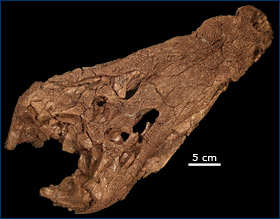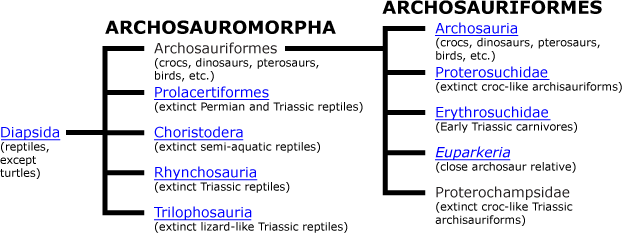
The Archosauromorpha, including Archosauriformes
An introduction to the phylogenetic taxonomy of Archosauromorpha
 The skull of the Paleocene crocodile Borealosuchus sternbergii (specimen no. 133903), collected by UCMP's J. Howard Hutchison in McCone County, MT, 1986; from the Tullock Formation. |
It is true that there are a lot of names to keep up with and that there are frequently changes in what a clade is called and what organisms are a part of it. Thatís because phylogenetic taxonomy represents our best understanding of the evolutionary relationships that bind all living things. As we gather more evidence and improve our understanding of the Tree of Life, the names of organisms must be changed to reflect that understanding. Knowing how groups of animals are related to one another gives us a way to test hypotheses about evolution, adaptation, and even extinction. We know these things because we have reconstructed the evolutioinary relationships among these animals.
In the old days, no one knew how the different groups of "thecodonts" were related — to each other, or to the more successful groups like dinosaurs and pterosaurs. That made it very hard to know how evolution worked in the group. Now we know that pterosaurs and dinosaurs were more closely related to each other than to most other archosaurs, and that the ancestors of living crocodiles were long-limbed animals that lived on land, and that adaptations like upright posture and bipedal locomotion evolved more than once in different groups of archosaurs. We know these things because we are able to put the different groups in a phylogenetic tree and figure out when they evolved and how they're related.
Archosauromorpha includes Archosauriformes (the traditional archosaurs) and a few groups of "not quite" archosaurs: Prolacertiformes, Choristodera, Rhynchosauria, and Trilophosauria.
Archosauriformes includes Archosauria (animals that are closely related to birds or crocs) and the old "thecodont" groups that are not closely related to either birds or crocs: Proterosuchidae, Erythrosuchidae, Euparkeria, and Proterochampsidae.

Archosauromorphs and archosauriforms filled a variety of niches. The majority were semiaquatic or terrestrial predators, but a few groups switched to herbivory. Most groups of archosauromorphs and archosauriforms lived only in the late Permian and Triassic. Outside of true archosaurs, the only groups that survived into the Jurassic were the choristoderes and protorosaurs.
The ecological roles filled by non-archosaur archosauromorphs and archosauriforms would be taken over by crocodiles and dinosaurs in the Jurassic and Cretaceous. The only notable exceptions are the croc-like choristoderes, which survived throughout the Mesozoic and well into the Cenozoic.
Text by Matt Wedel, 5/2007; edits by Judy Scotchmoor and Anna Thanukos, 11/2011; Borealosuchus photo by Dave Smith, UCMP